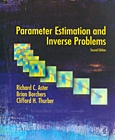- About MAA
- Membership
- MAA Publications
- Periodicals
- Blogs
- MAA Book Series
- MAA Press (an imprint of the AMS)
- MAA Notes
- MAA Reviews
- Mathematical Communication
- Information for Libraries
- Author Resources
- Advertise with MAA
- Meetings
- Competitions
- Programs
- Communities
- MAA Sections
- SIGMAA
- MAA Connect
- Students
- MAA Awards
- Awards Booklets
- Writing Awards
- Teaching Awards
- Service Awards
- Research Awards
- Lecture Awards
- Putnam Competition Individual and Team Winners
- D. E. Shaw Group AMC 8 Awards & Certificates
- Maryam Mirzakhani AMC 10 A Awards & Certificates
- Two Sigma AMC 10 B Awards & Certificates
- Jane Street AMC 12 A Awards & Certificates
- Akamai AMC 12 B Awards & Certificates
- High School Teachers
- News
You are here
Parameter Estimation and Inverse Problems

Publisher:
Academic Press
Publication Date:
2012
Number of Pages:
360
Format:
Hardcover
Edition:
2
Price:
99.95
ISBN:
9780123850485
Category:
Textbook
[Reviewed by , on ]
Fernando Q. Gouvêa
03/29/2012
This is the second edition of a book first published in 2005. The book "developed from a course taught to first- and second-year graduate students in geophysics, hydrology, mathematics, astrophysics, and other disciplines." Paul Phillips, who reviewed the first edition for us, described it as a fine introduction to inverse problems for students in applied fields, paying particular attention to geophysical problems.
The major changes for the second edition are two. In chapter 7, there are new sections discussing sparsity regularization, which has become an important topic in recent years. Chapter 11 now includes coverage of another hot topic, Markov Chain Monte Carlo methods for sampling from the posterior distribution in the Bayesian approach to linear and nonlinear inverse problems. In addition, several chapters were rewritten in response to reader comments.
Fernando Q. Gouvêa is the editor of MAA Reviews.
Preface
Chapter 1: Introduction
1.1 Classification of Parameter Estimation and Inverse Problems
1.2 Examples of Parameter Estimation Problems
1.3 Examples of Inverse Problems
1.4 Discretizing Integral Equations
1.5 Why Inverse Problems are Hard
1.6 Exercises
1.7 Notes and Further Reading
Chapter 2: Linear Regression
2.1 Introduction to Linear Regression
2.2 Statistical Aspects of Least Squares
2.3 An Alternative View of the 95% Confidence Ellipsoid
2.4 Unknown Measurement Standard Deviations
2.5 L1 Regression
2.6 Monte Carlo Error Propagation
2.7 Exercises
2.8 Notes and Further Reading
Chapter 3: Rank Deficiency and Ill Conditioning
3.1 The SVD and the Generalized Inverse
3.2 Covariance and Resolution of the Generalized Inverse Solution
3.3 Instability of the Generalized Inverse Solution
3.4 A Rank Deficient Tomography Problem
3.5 Discrete Ill-Posed Problems
3.6 Exercises
3.7 Notes and Further Reading
Chapter 4: Tikhonov Regularization
4.1 Selecting a Good Solution
4.2 SVD Implementation of Tikhonov Regularization
4.3 Resolution, Bias, and Uncertainty in the Tikhonov Solution
4.4 Higher-Order Tikhonov Regularization
4.5 Resolution in Higher-Order Tikhonov Regularization
4.6 The TGSVD Method
4.7 Generalized Cross-Validation
4.8 Error Bounds
4.9 Exercises
4.10 Notes and Further Reading
Chapter 5: Discretizing Inverse Problems Using Basis Functions
5.1 Discretization by Expansion of the Model
5.2 Using Representers as Basis Functions
5.3 The Method of Backus and Gilbert
5.4 Exercises
5.5 Notes and Further Reading
Chapter 6: Iterative Methods
6.1 Introduction
6.2 Iterative Methods for Tomography Problems
6.3 The Conjugate Gradient Method
6.4 The CGLS Method
6.5 Resolution Analysis For Iterative Methods
6.6 Exercises
6.7 Notes and Further Reading
Chapter 7: Additional Regularization Techniques
7.1 Using Bounds as Constraints
7.2 Sparsity Regularization
7.3 Using IRLS to Solve L1 Regularized Problems
7.4 Total Variation
7.5 Exercises
7.6 Notes and Further Reading
Chapter 8: Fourier Techniques
8.1 Linear Systems in the Time and Frequency Domains
8.2 Linear Systems in Discrete Time
8.3 Water Level Regularization
8.4 Tikhonov Regularization in the Frequency Domain
8.5 Exercises
8.6 Notes and Further Reading
Chapter 9: Nonlinear Regression
9.1 Newton's Method for Solving Nonlinear Equations
9.2 The Gauss-Newton and Levenberg-Marquardt Methods for Solving Nonlinear Least Squares Problems
9.3 Statistical Aspects of Nonlinear Least Squares
9.4 Implementation Issues
9.5 Exercises
9.6 Notes and Further Reading
Chapter 10: Nonlinear Inverse Problems
10.1 Regularizing Nonlinear Least Squares Problems
10.2 Occam's Inversion
10.3 Model Resolution in Nonlinear Inverse Problems
10.4 Exercises
10.5 Notes and Further Reading
Chapter 11: Bayesian Methods
11.1 Review of the Classical Approach
11.2 The Bayesian Approach
11.3 The Multivariate Normal Case
11.4 The Markov Chain Monte Carlo (MCMC) Method
11.5 Analyzing MCMC Output
11.6 Exercises
11.7 Notes and Further Reading
Chapter 12: Epilogue
A Review of Linear Algebra
A.1 Systems of Linear Equations
A.2 Matrix and Vector Algebra
A.3 Linear Independence
A.4 Subspaces of Rn
A.5 Orthogonality and the Dot Product
A.6 Eigenvalues and Eigenvectors
A.7 Vector and Matrix Norms
A.8 The Condition Number of a Linear System
A.9 The QR Factorization
A.10 Complex Matrices and Vectors
A.11 Linear Algebra in Spaces of Functions
A.12 Exercises
A.13 Notes and Further Reading
B Review of Probability and Statistics
B.1 Probability and Random Variables
B.2 Expected Value and Variance
B.3 Joint Distributions
B.4 Conditional Probability
B.5 The Multivariate Normal Distribution
B.6 The Central Limit Theorem
B.7 Testing for Normality
B.8 Estimating Means and Confidence Intervals
B.9 Hypothesis Tests
B.10 Exercises
B.11 Notes and Further Reading
C Review of Vector Calculus
C.1 The Gradient, Hessian, and Jacobian
C.2 Taylor's Theorem
C.3 Lagrange Multipliers
C.4 Exercises
C.5 Notes and Further Reading
D Glossary of Notation
Bibliography
Index
- Log in to post comments




